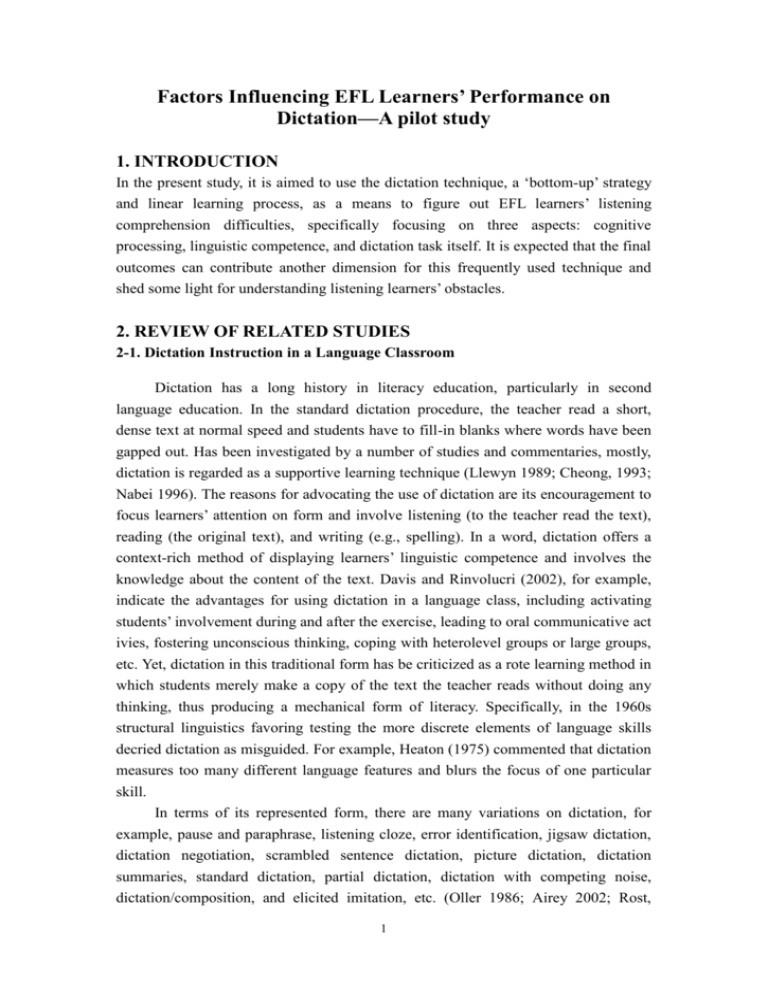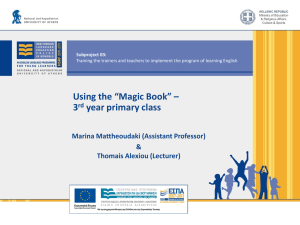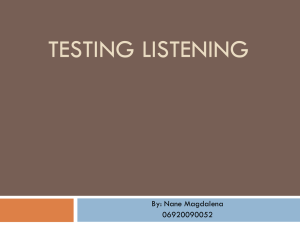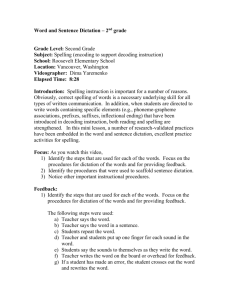Dictation Task Factors
advertisement

Factors Influencing EFL Learners’ Performance on Dictation—A pilot study 1. INTRODUCTION In the present study, it is aimed to use the dictation technique, a ‘bottom-up’ strategy and linear learning process, as a means to figure out EFL learners’ listening comprehension difficulties, specifically focusing on three aspects: cognitive processing, linguistic competence, and dictation task itself. It is expected that the final outcomes can contribute another dimension for this frequently used technique and shed some light for understanding listening learners’ obstacles. 2. REVIEW OF RELATED STUDIES 2-1. Dictation Instruction in a Language Classroom Dictation has a long history in literacy education, particularly in second language education. In the standard dictation procedure, the teacher read a short, dense text at normal speed and students have to fill-in blanks where words have been gapped out. Has been investigated by a number of studies and commentaries, mostly, dictation is regarded as a supportive learning technique (Llewyn 1989; Cheong, 1993; Nabei 1996). The reasons for advocating the use of dictation are its encouragement to focus learners’ attention on form and involve listening (to the teacher read the text), reading (the original text), and writing (e.g., spelling). In a word, dictation offers a context-rich method of displaying learners’ linguistic competence and involves the knowledge about the content of the text. Davis and Rinvolucri (2002), for example, indicate the advantages for using dictation in a language class, including activating students’ involvement during and after the exercise, leading to oral communicative act ivies, fostering unconscious thinking, coping with heterolevel groups or large groups, etc. Yet, dictation in this traditional form has be criticized as a rote learning method in which students merely make a copy of the text the teacher reads without doing any thinking, thus producing a mechanical form of literacy. Specifically, in the 1960s structural linguistics favoring testing the more discrete elements of language skills decried dictation as misguided. For example, Heaton (1975) commented that dictation measures too many different language features and blurs the focus of one particular skill. In terms of its represented form, there are many variations on dictation, for example, pause and paraphrase, listening cloze, error identification, jigsaw dictation, dictation negotiation, scrambled sentence dictation, picture dictation, dictation summaries, standard dictation, partial dictation, dictation with competing noise, dictation/composition, and elicited imitation, etc. (Oller 1986; Airey 2002; Rost, 1 2002). In regard to different teaching contexts, teachers verify the type of dictation to fit their own teaching purposes. 2-2. Possible Factors Influencing Performance on Dictation Listening comprehension is not only looking at the final outcome by selecting a correct item in multiple-choice questions; instead, ‘processes’ should be the concern to investigate what difficulties are encountered while they are listening to a text. It appears that until we have some diagnostic procedures, the teacher can only continue to test comprehension, not to teach it. We need to move to a position where the teacher is able to recognize particular patterns of behavior manifested by an unsuccessful listener and to provide exercises for the student which will promote superior patterns of behavior. With this significant motivation, it seems worth investigating roots of problems for future learning and teaching. Regarding to factors influencing listening comprehension, several results of research literature are generalized in the present study (e.g., Anderson 1990, O’Malley et al. 1989, Boyle 1984, Samuels 1984, Powers 1986, Underwood 1990, Rubin 1994, Goh 2000, Teng 2002, McCarthy 2002, Nunan 2002). To investigate EFL learners’ listening difficulties, two main directions lead this study, including student factors and dictation task factors. In terms of the former, student factors, three parts will be considered: cognitive process factors, linguistic proficiency factors, and other factors which can not be grouped under the previous two categories (e.g., note-taking ability). Regarding to the later, dictation task factors, two elements are further analyzed: text factors and dictation presentation mode factors. Related studies regarding to the above factors are further discussed as follows. Student Factors Cognitive Process Factors Anderson (1990), based on first language (L1) comprehension, defines a cognitive framework of language comprehension and divides the comprehension process into three phases: perception, parsing and utilization. In the first phase, perception, listeners’ attention is focused on the sounds and they try to decode the acoustic message. In the next step, parsing, words are transformed into a meaningful mental representation. Finally, listeners utilize the input which “consists of relating a mental representation of the message to the existing knowledge” (O’Malley et al., 1989, p.421). Anderson further indicates that these three phases of listening comprehension is recursive and overlapping rather than occurring in distinct stages. After one decade, Goh (2000) expands Anderson’s results and conducts a study to investigate 40 Chinese students’ listening difficulties. In other words, Goh shifts the 2 context to a second language (L2) learning context. By three research sources, including weekly diaries, group semi-structured interview, and immediate retrospective verbalization procedure, she concludes ten main listening problems for participants, which is shown in Table 1. Table 1 Problems Related to Different Phases of Listening Comprehension Perception Parsing Utilization 1. Do not recognize words 2. Quickly forget what is 4. Understand words but not they know 3. heard 5. the intended message Neglect the next part when thinking about meaning Unable to form a mental representation from words heard Cannot chunk streams of speech Do not understand subsequent parts of input because of earlier problems Miss the beginning of texts Confused about the key ideas in the message Concentrate too hard or unable to concentrate Among those generalized problems, in her study, Goh finds that ‘quickly forget what is heard’, ‘do no recognize words they know’, ‘understand words but not the intended message’, ‘neglect the next part when thinking about meaning’, and ‘unable to form a mental representation from words heard’ are the five most common obstacles for her participants. In the current study, her ten items will be included in the self-report checklist for learners to self-exam their cognitive problems. Since in both Goh’s and the researcher’s participants are from quite similar backgrounds, a Chinese-native-speaking context, it is assumed that some overlapping outcomes may occur in findings. Yet, this unproven assumption will be further explained in the finding section. Linguistic Competence Factors Generalizing the findings in previous related studies referring to listening difficulties, elements influencing dictation comprehension can be categorized in two aspects: linguistic competence and sociocultural knowledge. For each aspect, there are some specified items. First, in terms of linguistic competence, four items referring to learners’ linguistic competence and ability to interpret text meaning are assorted, including verb tense, topic progression, tone and their meanings, and linkage sound, etc. Second, another two points concern about social context and cultural aspects, of the associations and references available to native users, which present obstacles to 3 comprehension (Anderson and Lynch 1988), including problems of interpretation (e.g., semantic meaning) and background and sociocultural competence. Other Related Ability Factor Regarding to some other ingredients of unsuccessful listening accomplishment, two causes are taken into consideration: note-taking ability and amount processing time. In terms of the former one, Chaudron, et, al. (1994) indicate two main functions that note-taking serves. First, it aids the encoding process by increasing meaningful chunking and thereby encoding of information, general level of attention, general efforts, and assimilation of new and old information. Second, taking notes also provides an external storage of information, e.g., helping rehearsal and providing mnemonics and information for reconstruction of memory. Considering about these importance of note-taking, it seems promising to learn listeners’ difficulties in note-taking. Making mention to the second factor, amount processing time, listeners are asked to reflect if the amount time left to them is sufficient enough to work on processing, including understanding, interpreting the text, and time for taking note. It is expected that, from learners’ responses, the outcome can help the instructor to learn how much time should be allotted appropriately in one dictation task. Dictation Task Factors In relation to the dictation task itself, two dimensions are included: text factors and dictation presentation mode factors. Text Factors This part includes organization of the text, text length, interest to the message, difficulty of content and concepts especially if the material is abstract, ambiguous, highly specialized or technical, esoteric, lengthy, or poorly organized, and learners’ familiarity with topic/subject matter. Dictation Presentation Mode Factors For this part, because the environment is in a language lab where provides good audio quality; thus, some factors such as noise or inadequate volume are excluded. In the current study, possible problems relating to presentation mode are: speed of delivery, repetition of the material, and clarity of speaker’s production, including voice, clarity, etc. After combining all the above possible factors involving learners’ performance in dictation, a checklist (See Appendix 2) is integrated for learners to do a self-report to reflect individual problems. 4 2-3. Why Use Dictation to Investigate Learners’ Listening Difficulties? There are two main reasons explaining why the current study uses dictation to probe learners’ problems in dictation performance. First, in one study conducted by Krashen (1996), he clearly concludes that narrow listening is a “low-tech, inexpensive, and pleasant way to obtain comprehensible input, and is also an easy way to get to know speakers of other languages” (p.97). Furthermore, many students in Taiwan are very familiar with dictation practice because they do the same practice in high school years. In this study, as what has been explained previously, expanding a blank from a single word to phrases or sentences seems doable for participants. Therefore, the researcher does not need to give a lot of training to make learners familiar with this task. It is efficient in both saving time and avoiding instruction confusion. Second, the reason that dictation works well is that the whole family of auditory tasks comprising faithfully reflect crucial aspects of the very activities that processes discourse auditorily. More specifically, it is a direct measure to get a closer look at listeners’ processing discourse from decoding the sounds in a linear fashion, noticing a form in the target language, solving linguistic problems, and finally, sorting out the final answers. According to Nunan’s (2002) definition, the task corresponds to bottom-up processing view closely, leading learners to develop “from the smallest meaningful units (phonemes) to complete texts” (p. 121). Based on this view, it is related to the reason why use dictation to explore learners’ listening difficulties. Hughes (2003) illuminates well, “As well as providing a ‘rough and ready’ measure of listening ability, it [partial dictation] can also be used diagnostically to test students’ ability to cope with particular difficulties” (p.168). Sharing the same view, from a process perspective, Field’s (1998) regards incorrect answers “can be seen to be of more significance than correct ones…the function of the teacher being to identify and redress learners’ weaknesses as listeners” (p.112). The most significant part is that learners take their own responsibility to find out their own problems instead of the teacher’s work. Particularly, the cognitive process that undergoes in learners’ mind can be faithfully reflected by themselves. As what stated in her book, Wajnryb (1990) suggests that “Through active learner involvement students come to confront their own strengths and weaknesses…In so doing, they find out what they need to know” (p.10). Therefore, the process of developing dictation exercises brings revealing effects both to the teacher and learners, figuring out the factors leading to comprehension break down since dictation precisely mirrors how listeners cope with discourse processing tasks. 5 3. The Study Research Questions 1. What listening difficulties EFL listeners encounter in dictation performance? 2. What are learners’ responses to group work in dictation tasks? Do they regard peers as facilitator? If so, in which way do they think peers help their dictation tasks? Participants 38 first-year college students, from Traditional Chinese Medical Department at Chang-Gung University, participated in the current study. They were taking Freshman English, a required-course, two class hours for each week and eighteen weeks for one semester. The average level of this class was from upper-intermediate to advanced, based on their English scores in the entrance exam, quizzes and at-class performance. In terms of course focus, one of the targets was to promote listening comprehension and oral communication. Therefore, the instructor usually distributed one period for listening and conversation practice. The current study was lasted for five weeks, two weeks for pre-training and three weeks for carrying out dictation tasks. In these three dictation practices, after each dictation task, learners were required to check their own problems with the checklist. Finally, the researcher collected all checklists and counted the final scores to sort out common listening difficulties. It is worth noticing that the instructor announced that their performance on dictation would not affect their final scores; rather, she expected and encouraged them to reflect faithfully in order to find their own individual problems. After their individual work, listeners could check their answers with group members. Therefore, learners did not have any pressure to concern about scores. All they needed to focus was to concentrate on doing dictation tasks, discussing with group members, and did a self-report to reflect individual’s problems through the whole process. Procedures (1) Preparation a. Text selection: several concerns were considered: text length (total word numbers in one text), interest and relevance of subject matter, general knowledge of the content avoiding involving any specific genre. More specifically, if possible, texts would contain some particular features. For example, the second chosen text, entitling ‘Ichiro Suzuki Breaking Baseball Record’, referred to many chronological year numbers and ordinal/cardinal numbers. In addition, according to Wajnryb’s (1990) definition on dictogloss, she indicates that teachers can write 6 their own creation or modify an existing text, for example, modifying a reading text into a colloquial text. However, the dilemma was that due to the concern of availability of foreigners’ recording, the researcher decided to adopt ready-to-go materials, articles in update language learning magazine or books with CDs, without any modification. b. Grouping learners: four students in one group, hetero-level. c. Pre-training: making participants familiar with dictation tasks and more important, confirming all participants know how to do self-report correctly, i.e., knowing how to identify and reflect their own problems by counting occurrence time of individual listening difficulties. In addition, the twice pre-trainings were crucial for the researcher, too. Through the two practices, she learned how much length of text is appropriate for target participants and measured how much times the text should be repeated. (2) During Dictation a. Schema building of the topic in dictation task, including pre-questions, related vocabulary discussion for about five to ten minutes. b. Before listeners started the dictation task, the instructor played the text twice and learners paid attention to the main ideas. In the meantime, they could jot down any information they received. After playing the text twice, listeners were asked to use their notes to reconstruct the whole text and summarized the main idea of the whole text in two sentences. They were given three to five minutes to reorganize their received information. c. The instructor distributed the written script with blanks (See a sample in Appendix 1) for conducting a dictation practice. At this stage, the instructor played the text sentence by sentence; that is, there was a pause between sentences. It was the third time to listen to the text. After that, the teacher repeated the whole text for another two times. To summarize, learners listened to key ideas in the first two times and fill-in blanks tasks in the last two times. d. Learners had to discuss and checked their answers with group members. Discussion time was about 10 to 15 minutes. They were asked to use another color pen to distinguish what changes they have made after the discussion. Also, different color pens helped listeners to recall their listening process while they were checking self-report form. e. After their discussion, the instructor checked the answer and made further explanation for particular questions. Meanwhile, learners had to use another color pen to mark what she and/or her group discussion fail to catch. (3) After Dictation 7 a. After each dictation exercise, learners used a checklist to do self-exam, investigating what problem she encounters in the task. Students had to do this self-report for three times (weeks). b. In the last week of this study, the instructor gave another short-question response sheet. The purpose of doing these short questions was to probe learners’ reflection to group work in particular (See Appendix 3). Data collection and analysis Data were elicited from learners’ self-reports through the counting results of checklists, short question reflection, and immediate retrospective verbalizations. These outcomes provided insights into real-time problems that listeners faced during practicing dictations. In other words, by counting the final results shown in the data, the current study utilized an ‘analysis-synthesis principle’ to generalize EFL learners’ listening difficulties. Findings and discussion (1) Listening Difficulties First of all, in terms of learners’ listening difficulties, four main findings were concluded. First, the results appear in Figure 1 show that learners suffered from recalling the vocabulary that they had learned. One of the most common complaints was that students know they have learned the word, but they just could not recall what it exactly means. Other factors influencing their dictation work were: neglect the next part when thinking about meaning, quickly forget what is heard, understand words but not the intended message, and fail to segment speech. Correspondently, the findings were quite similar to the results in Goh’s (2000) study. Figure 1. Five common cognitive process problems 8 Second, as Figure 2 indicates, in relation to linguistic competence obstacles, problems of vocabulary knowledge, including spelling and lack of word knowledge, were the hardest parts to overcome. Besides vocabulary knowledge problems, verb tense and numbers were challenging for listeners to recognize. What is notable is that learners reflected their troubles in note-taking ability. The blanks in partial dictation tasks, as what have mentioned in previous part, not only included one single word; more than this, phrases and utterances were also alternatives. Therefore, listeners encountered challenges to use their cognitive memory to memorize and later recall a long phrase or an utterance. If not with this capacity, it is required to rely on their note-taking ability. However, the results revealed their dilemma in both insufficient capacity in cognitive memory and inability to take notes. It thus is a significant finding for raising teachers’ awareness in selecting proper materials and providing practice opportunities to train listeners’ short-term memory and their ability to take notes. Finally, tone and its implying meaning reduced effective listening comprehension in dictation tasks. Figure 2. Six common linguistic difficulties Third, Figure 3 discusses the problems in dictation task itself. As the results showed, speed of delivery and clarity of speaker’s production were the characteristics that learners concerned most. In addition, the length of texts, difficulty of content and concepts and learners’ familiarity with topic/subject matter were the consequent three distresses that learners worried most. These findings were particularly significant to be the teacher’s guidelines for material selection and dictation task design. There were many dimensions to be considered while selecting listening materials for teaching and learning, however, these five factors represented learners’ concerns while learning. 9 Figure 3. Five common difficulties in dictation tasks Finally, after generalizing all items, the most ten general listening difficulties are represented in Figure 4 as follows. Figure 4. Ten common problems in performing dictation tasks As the results indicated, linguistic competence was the most severe test for listeners, including vocabulary (spelling and lack of knowledge of the word for 98 times respectively), verb tense (45 times), and failure to recognize numbers (42 times). The total number of linguistic competence difficulties was 283 times, acting as the most significant element influencing learners’ performance on dictation work. The second considerable perspective was learners’ cognitive process problems in coping with input: failing to recall the meaning of the word that they had learned before (99 times), being deficient to follow the next part when thinking about meaning (54 times), quickly forgetting what is heard (50 times), and understanding the word but not the intended message (30 times). The total number of these cognitive problems was 233 times. To sum up, it was very possible that these linguistic incompetence and cognitive process obstacles lead to listeners’ inability to take note well (37 times) while encountering longer blanks. However, in terms of the exact 10 factors causing learners’ unsuccessfulness in note-taking, it still needs further study. The last reason affecting dictation performance was speed of delivery. It implied that the teacher should repeat or slow down the speed of delivery for listeners to catch the meaning and have sufficient time to process the content. (2) Learners’ attitude toward group work in dictation tasks After collecting all the short question answers, it was found that most students (30 out of 38) held a positive attitude toward group work in dictation tasks while three students stood in a negative side and five considered it made no difference. Among those thirty students who regarded group members as facilitators, some major reasons explaining why they prefer group work are as follows. 1. It makes me lower anxiety. (S37) 2. Group work helps me confirm uncertainty and doubt. So, it makes me feel much comfortable and confident rather than my own individual work. (S45) 3. Teammates make up the parts where I neglect. (S25) 4. Through discussion, I get a deeper impression, especially where I made mistakes. (S28) 5. I like it because it is a reciprocal learning. (S31) 6. It’s nice to make an immediate correction right after I listen to the text. (S29) Generally speaking, the analysis of the transcripts of collaborative interaction revealed that peer assistance was a systematic strategy for those learners. Most of time, it helped them to make up for lapses in concentration. According to their answers, spelling, phrase/collocation, word meaning, text structure, pronunciation, verb tense, and singular or plural noun forms were the most frequently discussed items. On the other side, three students who disagreed with the group work stated that, “I think that the group discussion misleads me sometimes. Besides, some members just escape from their duties.” (S48) Another student reflected that, “I think it is very troublesome and time-consuming. Once in a while, unequal work distribution made me feel unpleasant.” (S6) To summarize, in a dictation discussion, the most difficult part in a group work seemed work distribution. The responses suggested that group number designed in the current study, four persons, might need justification. Two or three may be a more appropriate number because since numbers are decreased, every team members’ work increases. Therefore, how many students should be grouped as a unit needs further consideration in continuing studies. 4. THEACHING IMPLICATIONS AND CONCLUSION Finally, some space will be devoted to discuss teaching implication after synthesizing all the findings. The first direction goes to the regard to linguistic 11 competence. From a macro perspective, while developing listening courses, materials and lessons, it is important, not only to teach bottom-up processing skills such as the ability to discriminate between minimal pairs, but also to help learners use what they have already known to understand the main idea in the receptive message. If teachers do not prepare learners to establish schema knowledge, it is very possible that listeners only do a decoding work in a dictation work, but not involving any further semantic or pragmatic comprehension. It is especially crucial in listening to a lecture or any subject referring to a specific field. Discussing from a micro perspective, three aspects are involved, including vocabulary knowledge, failure to recognize verb tense, numbers and tone. First, it is obvious in the results that vocabulary knowledge is the most serious problem in linguistic competence, including both in lack of knowledge of a new word and incapacity to recall the meaning of learned words. Accordingly, how to expand learners’ word knowledge and recycle learned words are crucial targets in a listening course. Intensive listening practices may help. Another concern under linguistic competence is referring to the reorganization of verb tense, numbers, and tone. It is suggested that in order to raise learners’ awareness, the listening materials selected for learners should contain some particular features, for example, gapping out verbs, numbers, or content words for listeners to concentrate on these particular difficulties they confront. Furthermore, repeating playing the listening text and reading aloud alongside scripted texts may help learners to become familiar with the real cadences of the target language and they will have a better sense of the meaning that different tones imply. Based on the findings, the other direction is concerning about cognitive process problems. The outcomes suggest that many learners only have limited memory of word meaning, which reveals that their retention of passive knowledge is not lasted long. Actually, leading learners to recognize and comprehend precisely, and further actively use a word correctly takes a long continuing work. Yet, how the teacher can facilitate learners to enhance their passive knowledge takes a lot of efforts. Two alternatives are suggested as follows. One, cultivating learners’ listening strategies is the first choice. However, as what Field (1998) indicates, “…the aim of strategy training should not be to teach a uniform set of procedure but to encourage the reluctant strategy-user and restrain the rash” (p. 116), that is, strategy-training is not a ‘one-shot’ panacea. Rather than introducing various listening strategies, more than that, some techniques such as body language, discourse features (e.g., reference or markers), predicting, anticipating or recognizing intonation cues, etc. also need to be included. The second option is to train learners to do summary practices. Learners can start from a short text and later expand to a longer text, increasing the challenging 12 degree gradually to make listeners be familiar with retaining information in mind and processing received message in a short period. Note-taking may be a proper tool to facilitate learners to reconstruct listening information. Through this classroom research, it helps the teacher to understand learners’ listening difficulties of these specific features; she can thus focus on several targets to design a listening course or select materials by allotting particular features for more effective learning. This corresponds to what Goh (2000) indicates that knowing how problems occur naturally locate EFL teachers in a better position to assist students coping with their listening obstacles. In some way, making every individual learner to exam his own problems also releases distress in listening comprehension and positively promote motivation for further learning step. Yet, some space needs to spare for discussing the limitation in the current study. First, the researcher should further do an in-depth interview with some students to learn more responses to individual problems and their attitude towards group work. This study only triggers some points, but further investigation is absolutely necessary. In addition, dictation task itself has some limitations, too. For example, some listeners may have the ability to decode the word or phrase, but fail to recognize the semantic meaning. For instance, one blank goes, “He just sent me on my way”. Most participants had no problem with decoding every single word, but none of them could exactly explain what the phrase ‘send me on my way’ means. It is possible that a listener just writes down (or repeats) sequences of material in English but he does not even understand it. In a classroom practice, one alternative in teaching implementation is to encourage learners to guess the meaning, but not necessarily to write in the target language. In other words, they can fill in the blank in their native language. By doing so, students lessen their anxiety and frustration of interpreting meanings. Also, not been hampered by one single word, learners get a better chance to comprehend and interpret main ideas of whole text. However, shifting the situation to serve a testing function, partial dictation questions which containing several words in one blank is hard to score. For example, if one student gets a mis-spelling of one word in an utterance, how the teacher will penalize the score become troublesome. Therefore, partial dictation is an appropriate learning method and tool for figuring out individual’s problems, as what most participants suggested in their reflections, but it needs some clarification if the teacher intends to use it to serve a testing function. However, undeniably, dictation, an old idea, provides the current study a new look at investigating listening teaching. 13 REFERENCES Anderson, A., & Lynch, T. 1988. Listening. New York: Oxford University Press. Anderson, J. R. 1990. Cognitive Psychology and its Implications. New York: W. H. Freeman. Airey, J. 2002. The way we do it. English Teaching Professional. Retrieved 10, Nov. Available: <http://www.etprofessional.com>. Boyle, J. P. 1984. Factors affecting listening comprehension. ELT Journal 38, 34-38. Buck, G. 1992. Listening comprehension: construct validity and trait characteristics. Language Learning 42(3), 313-357. Chaudron, C., Loschky, L., & Cook, J. 1994. Second language listening comprehension and lecture note-taking. In Academic Listening—Research Perspective, Flowerdew, J. (ed.), 75-92. Cambridge: Cambridge University Press. Cheong, C. W. Y. 1993. The dictogloss procedure as a vehicle of grammatical consciousness-raising: A case study. Unpublished master’s dissertation, National University of Singapore. Davis, P., & Rinvolucri, M. 2002. Dictation: New methods, new possibilities. Cambridge: Cambridge University Press. Field, J. 1998. Skills and strategies: towards a new methodology for listening. ELT Journal 52 (2), 110-118. Goh, C. C. M. 2000. A cognitive perspective on language learners’ listening comprehension problems. System 28, 55-75. Heaton, J. B. 1975. Writing English language tests. London: Longman. Hughes, A. 2003. Testing for Language Teachers. Cambridge: Cambridge University Press. Krashen, S. D. 1996. The case for narrow listening. System 24(1), 97-100. Llewyn, S. 1989. The dictogloss procedure and grammatical consciousness-raising: Classroom-based research. Prospect 5(1), 31-37. McCarthy, M. 2002. Discourse Analysis for Language Teachers. Cambridge: Cambridge University. Nabei, T. 1996. Dictogloss: Is it an effective language learning task? Working papers in Educational Linguistics 12(1), 59-74. Nunan, D. 2002. Listening in A Second Language. Taipei, Taiwan: Selected Papers from the Eleventh International Symposium on English Teaching/ Eleventh Pan-Asian Conference. O’Malley, M., Chamot, A., & Kupper, L. 1989. Listening comprehension strategies in second language acquisition. Applied Linguistics 10, 418-37. Oller, J. W., Jr. 1986. Language Tests at School. Singapore: Longman. Powers, D. E. 1986. Academic demands related to listening skills. Language Testing 3, 1-38. Rost, M. 2002. Teaching and Researching Listening. Hong Kong: Longman. Rubin, J. 1994. A review of second language listening comprehension research. MLJ 78, 199-221. Samuels, S. J. 1984. Factors influencing listening: Inside and outside the head. Theory into Practice 23, 183-189. Teng, H-C. 2002. An investigation of EFL listening difficulties for Taiwanese college students. Taipei, Taiwan: Selected Papers from the Eleventh International Symposium on English Teaching/ Fourth Pan-Asian Conference. Underwood, M. 1990. Teaching Listening. New York: Longman. Wajnryb, R. 1990. Grammar dictation. Oxford: Oxford University Press. 14 Appendix 1: Sample of Dictation Text A Tale of Two Doctors: A Personal Experience It started with a tiny blister on my fingers, then another, and another. Soon, my hands were covered with them. They weren’t painful at first, but after a week, they became itchy, so I scratched them. The blisters burst, leaving me with sores all over my hands. It was horrible and I had no idea what was causing them. Allergies? Stress? Some rare tropical disease? I need help. I went to NTU Hospital. During a very brief exam, the doctor looked at my hands. He asked a few obvious questions, such as, “Do they hurt?” He said I had eczema and gave me some cream. He told me to keep my had clean and dry, and sent me on my way. The cream stopped the itching, but made my skin very dry. Within a few days, I had lost two layers of skin, leaving my hands bloody and raw. I was in even more pain than before. Appendix 2: Self-report Checklist Mark your listening difficulties and count your linguistic errors Listening Difficulties 1. Do not recognize words they know 2. Neglect the next part when thinking about meaning 3. Cannot chunk streams of speech 4. Miss the beginning of texts 5. Concentrate too hard or unable to concentrate 6. Quickly forget what is heard 7. Unable to form a mental representation from words heard 8. Do not understand subsequent parts of input because of earlier problems 9. Understand words but not the intended message 10. Confused about the key ideas in the message 11. Linguistic complexity: a. Verb tense b. Too many subjects in one text (topic progression) c. Tone and their meaning d. Linkage sound 12. Vocabulary: a. Don’t know the word b. Vocabulary load c. Idiom/slang d. Collocation/phrase e. Spelling 13. Failure to recognize the ‘signals’ 14. Failure to recognize numbers (e.g., ordinal/cardinal numbers or chronological year number) 15. Problem of interpretation semantic meaning 16. Background/ Sociocultural competence 17. Note-taking ability 18. Amount of processing time 19. Poor organization of the text 20. Too lengthy 21. Interest to the message 22. Difficulty of content and concepts, especially if the material is abstract, ambiguous, highly specialized or technical, or esoteric 23. Familiarity with topic/subject matter 24. Speed of delivery 25. Repetition of the material 26. Clarity of speaker’s production: voice, clarity, etc. 15 Date ____________ Time(s) Total Appendix 3: Short Questions Group work: 1 ○ What do you think about group work (in either positive or negative way, or both of them)? Generally speaking, do you prefer a group or individual work? 2 ○ While you are discussing with group members, what do you usually work with peers? List three most frequently discussed items (e.g., spelling, word meaning, etc.) 16








